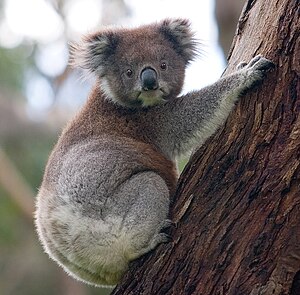Australidelphia
| Australidelphia | ||||||||||||
|---|---|---|---|---|---|---|---|---|---|---|---|---|

Koala ( Phascolarctos cinereus ) |
||||||||||||
| Systematics | ||||||||||||
|
||||||||||||
| Scientific name | ||||||||||||
| Australidelphia | ||||||||||||
| Szalay , 1982 | ||||||||||||
| Orders | ||||||||||||
|
The Australidelphia , for which no German name exists so far, form one of the two superordinate groups within the subclass of the marsupial mammals (Metatheria) alongside the Ameridelphia . They include all representatives of this group that are native to Australia , New Guinea and nearby islands, as well as a single species living in South America , the Chiloe opossum ( Dromiciops gliroides ), which is in its own order Microbiotheria. Paleontologically , they are also passed down from Antarctica .
In addition to the biogeographical facts, the group is mainly based on molecular biological data. A specialization of the tarsal bones is considered as a common morphological characteristic.
Tribal history
Depending on the author, the information about when the Australidelphia split off from their sister group , the Ameridelphia, vary between 128 million and 61.7 million years ago. The latest estimates assume a separation about 75 million years ago. Most of the Australidelphia then probably immigrated to Australia via Antarctica . It was only after the dinosaurs became extinct about 65 million years ago, however, that they were able to develop into the dominant group of land animals there. The first fossil evidence of marsupial mammals in Australia does not come from the Eocene era about 54 million years ago; a clear assignment of the find made in southeast Queensland to the Australidelphia has not yet been established.
With the exception of the South American Microbiotheria, the Australidelphia were isolated from the rest of the mammal world for about 30 million years due to the separation of Australia from all other continents, only about 8 million years ago one found representatives of the higher mammals with immigrated rodents (Rodentia) . The immigration of modern humans ( Homo sapiens ) then led to a mass extinction about 45,000 years ago that affected the entire Australian megafauna and thus also its most important group, the Australidelphia.
Cases of Convergent Evolution
A comparison of the Australidelphia with other groups of mammals shows some very interesting cases of convergent evolution . It is, for example, both the ants marsupials ( Myrmecobius fasciatus ) and in the Laurasiatheria counted Erdwölfen ( Proteles cristatus ) and aardvarks ( Orycteropus afer ) that the Afrotheria belong, come to a strong recovery of the teeth. Due to their common life underground, the sac mole (Notoryctemorphia), the real moles belonging to the Laurasiatheria (Talpidae) and the golden mole (Chrysochloridae) have developed extremely convergent. Ecological equivalents, on the other hand, are kangaroos (Macropodidae) and ungulates such as odd- toed ungulates (Perissodactyla) and even ungulates (Artiodactyla).
The Australidelphia are also interesting because some species have conquered the airspace as passive fliers. This has even apparently happened three times independently of each other: With the glide pouches (Petauridae), the giant glide pouches ( Petauroides ) and the dwarf glide pouches (Acrobatidae).
Systematics
The Australidelphia are listed here with five orders:
- The Microbiotheria include with Dromiciops only a recent type comprising three types that are native in Chile.
- The pouch mole (Notoryctemorphia) are the marsupial equivalents of the moles and comprise two species in a genus Notoryctes .
- The predator-like (Dasyuromorphia) are divided into two living families, the predator (Dasyuridae) and the ant- clump (Myrmecobiidae). Until the 20th century there was a third family, Thylacinidae, which included the thylacine ( Thylacinus cynocephalus ). The last animal died in captivity in 1936.
- The nasal sacs (Peramelemorphia) comprise around 20 species, divided into three families.
- The Diprotodontia are the most species-rich order and also include a large variety of types: The well-known kangaroos (Macropodidae) and koalas ( Phascolarctos cinereus ), the wombats (Vombatidae) and the three families of gliding marsupials belong here.
There is uncertainty about the voting lines within this group. In 2003, Heather Amrine-Madsen presented the following cladogram based on molecular genetic comparisons (quoted from Kemp, 2005):
| Australidelphia |
|
||||||||||||||||||||||||
|
|
Other approaches, however, combine the nasal sacs and Diprotodontia to form a taxon Syndactyli, which is morphologically supported by the fused together second and third toes of the hind limbs, but possibly only represents an analogy . Still other studies place the Chiloé opossum and the Diprotodontia in a common lineage and see the nasal sacs as sister taxons of the rest of Australidelphia. So there is no generally recognized phylogenetic system of the marsupial. The attempt to systematize is made more difficult by large gaps in the fossil record.For example, there have been no finds of the Australian species between the time 55 million years ago and the time 25 million years ago, when today's orders were largely established.
literature
- TS Kemp: The Origin & Evolution of Mammals. Oxford University Press, Oxford 2005, ISBN 0198507615